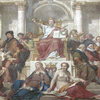'A profitable company'. Het pantheon als historisch genre in het negentiende-eeuwse België
DOI:
https://doi.org/10.18352/bmgn-lchr.5217Keywords:
Cultural HistoryAbstract
'A profitable company'. The national pantheon as a historical genre in nineteenth-century Belgium
After the Revolution of 1830, the new Belgian nation state was in a patriotic mood. It celebrated its national glory in pantheons, imaginary temples in which the heroes from the national past were represented and accumulated. These pantheons were almost omnipresent in the public spaces of the kingdom. They familiarized the Belgians with their heroic ‘forefathers’ and with their legacy. The meaning and message of these pantheons were easily accessible. The sculpted, painted and written specimens of the genre could adopt various forms and could be composed according to different schemes. The national heroes were gathered either in a series of individual portraits or in a single group portrait. Often they displayed a hierarchic structure. The discussions about the medium concerned the selection and selectivity of the series and compositions: who could be allowed to enter the Hall of Fame of the nation, and was it not too crowded? Moreover, the excessive growth of the number of pantheons threatened to undermine their effectiveness. King Leopold II made various attempts to raise one National Monument in honour of the heroes of the nation, after the exemple of the Walhalla of Ludwig I of Bavaria. But the pantheon had lost prestige by the end of the nineteenth century. As an expression of the historical culture it had become marginal. Only within the framework of the debate on the ‘layered’ Belgian nationality, did a certain revival occur. In the year 1930, the Flemish subnation established its own pantheons.
Downloads

Downloads
Published
Issue
Section
License
Authors who publish with this journal agree to the following terms:
a) Authors retain copyright and grant the journal right of first publication with the work simultaneously licensed under a Creative Commons Attribution 4.0 International (CC BY 4.0) that allows others to share the work with an acknowledgement of the work's authorship and initial publication in this journal.
b) Authors are able to enter into separate, additional contractual arrangements for the non-exclusive distribution of the journal's published version of the work (e.g., post it to an institutional repository or publish it in a book), with an acknowledgement of its initial publication in this journal.
c) Authors are permitted to post their work online (e.g., in institutional repositories or on their website) prior to and during the submission process.
Authors are explicitly encouraged to deposit their published article in their institutional repository.











